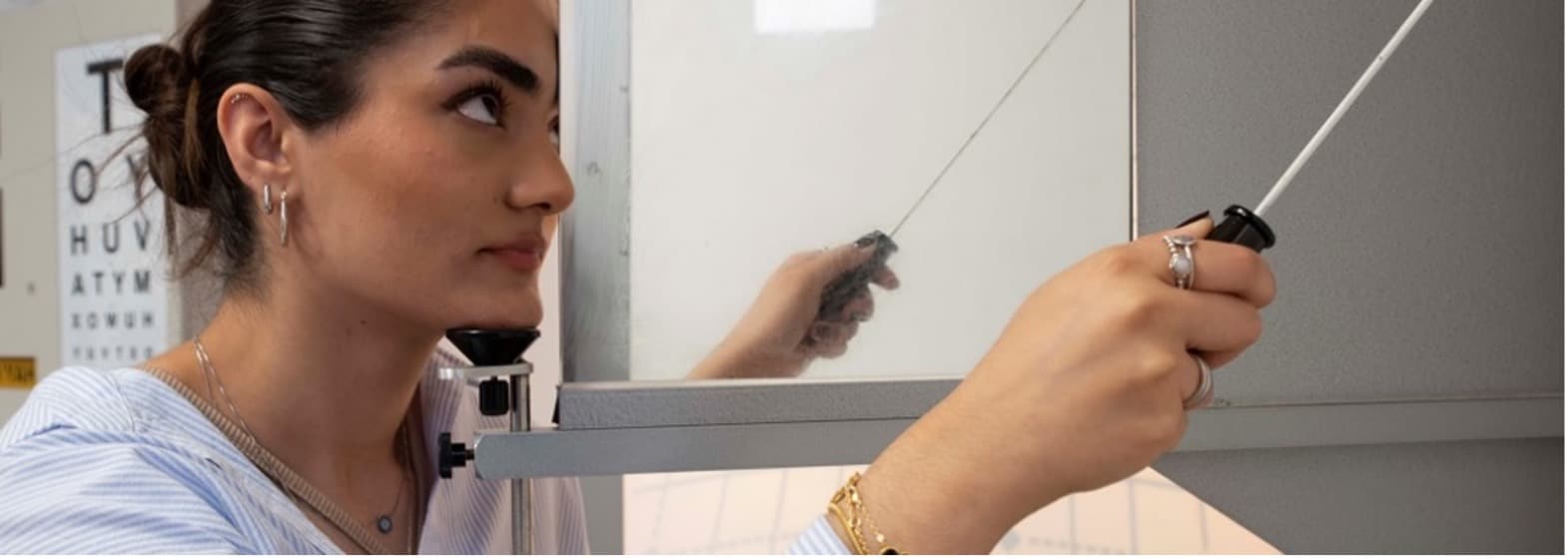
Orthoptics – The A To Z Of Allied Health
Orthoptics is an allied health profession involved in eye healthcare. Orthoptists are experts in assessing, diagnosing, and managing disorders of vision and/or eye movements.
What does an orthoptist do?
Orthoptists often work with young infants experiencing common eye conditions such as strabismus (misalignment of the eyes), amblyopia (better known as “lazy eye”), refractive errors (glasses), congenital and infantile cataract, and problems with eye movement. They also support adults with these conditions and other eye health problems that may arise later in life and cause symptoms such as double vision, blurring, and uncontrolled eye movements. They also commonly work with patients with neurological conditions, (e.g., stroke, brain tumours, multiple sclerosis), thyroid disease or after head trauma, as part of a wider multi-professional team. They help patients to manage the visual symptoms of their condition and provide advice for the visual and general rehabilitation of these patients.
Orthoptists have the opportunity to undertake further training and study to gain an extended knowledge base to support the wider ophthalmic workforce. Some examples of the specialist orthoptic services include supporting children with visual processing difficulties and people with low vision. Extended and advanced roles in some countries include orthoptists being involved in glaucoma service provision and carrying out intravitreal treatment for retinal conditions. They also undertake eye examinations for the evaluation of occupational standards and driving safety.
Where do orthoptists work?
Orthoptists work in numerous countries including Australia, the USA, Canada, the UK, New Zealand, Malaysia, Hong Kong, Japan, Pakistan, and Singapore. Orthoptists typically work in healthcare settings including hospitals, rehabilitation centres, and in private specialist eyecare practices. They can also work in academia, research centres, and depending on the requirements in each country, they may work in the ophthalmic retail sector.
In the UK and USA, orthoptists mainly work in hospitals. Orthoptists may also work alongside an ophthalmologist in private practice.

Professional education and regulatory frameworks for orthoptics
In Australia, aspiring orthoptists can complete a four-year Bachelor of Orthoptics degree or a 2-year graduate level Master of Orthoptics with supervised clinical practice embedded throughout. There are also postgraduate research degree options within orthoptics education.
Those looking to qualify as an orthoptist in Canada can complete a Master’s level Clinical Vision Science Program, or a hospital-based training program for those that hold a suitable undergraduate degree. Prospective orthoptics students in the USA complete two years of course work with clinical experience opportunities or undertake an Orthoptics Fellowship program.
To qualify as an orthoptist in the UK, a Bachelor’s of Orthoptics degree is required. Alternatively, if an aspiring orthoptist has a relevant undergraduate degree, they can enrol in a two-year Master’s pre-registration degree. Orthoptic students undertake clinical practice throughout both courses. There are currently no training programs for orthoptists in New Zealand.
In the UK, the orthoptics profession is regulated at the national level by the Health and Care Professions Council. However, it is self-regulated in Australia, the USA, Canada, the UK, and New Zealand.
Who should do orthoptics?
Individuals who have a keen interest in healthcare, are good communicators and compassionate should apply to study orthoptics and practice a challenging, rewarding and varied career.
Workforce considerations
The Orthoptist is an integral part of the Ophthalmic team and is a growing profession as they extend their skills to support the eye health care workforce to care for the ageing population. There are currently approximately 1500 orthoptists registered with the Health and Care Professions Council in the UK. There are fewer than 400 orthoptists practising in the USA. In some countries, there are limited education and training opportunities for aspiring orthoptists, including insufficient supervised clinical practice opportunities, hence it is very likely that workforce shortages will be a major issue for those areas.
Find out more
Here are some links to websites and resources:
- The International Orthoptics Association comprises member countries where orthoptics is recognised by statute.
- The European Orthoptics Association comprises orthoptists from EU countries.
- The British and Irish Orthoptic Society is the UK professional body for Orthoptists.
- Orthoptics Australia is a national organisation representing members in all states of Australia as well as members from other countries.
- American Association of Certified Orthoptists
- Canadian Orthoptic Council
- New Zealand Orthoptics Society Inc.
- Japanese Association of Certified Orthoptists
- Pakistan Orthoptics
If you have questions about this profession, or if you wish to share your experiences as an orthoptist, please leave a comment below.
Subscribe to Allied Health Insights to receive incisive and up-to-date allied health commentary and solutions. | Browse our range of insights into the allied health professions here.
If you offer professional development or business support services for orthoptists or their employers, please list your business on our Service Directory.
AHP Workforce provides orthoptic workforce planning, strategy and consulting for employers, managers and public sector stakeholders. For allied health workforce solutions, contact us today.





